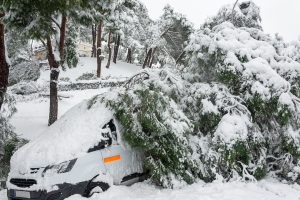Prepare your trees for spring in Colorado. With fluctuating temperatures, strong winds, and sudden storms, it’s necessary to take proactive steps to protect your trees from potential damage. Inspecting for winter damage is crucial – look for broken branches, cracked bark, and signs of disease or pests.
Remember to mulch and fertilize to provide necessary nutrients and promote healthy growth. Proper watering is key during Colorado’s dry spring months, so water deeply and infrequently to encourage deep root growth. Keep an eye on weather forecasts for potential frost damage, and consider planting frost-resistant species. Pruning with care, monitoring for pests and diseases, and supporting young trees are all important aspects of ensuring your trees thrive in the face of Colorado’s unpredictable spring weather. Call our experts for tree consultations and services to keep your trees healthy and resilient.
Prepare your trees for spring in Colorado!
Key Takeaways:
- Inspect for Winter Damage: Check for broken branches, cracked bark, and signs of disease to promote healthy growth.
- Water Wisely: Monitor soil moisture levels and water deeply to encourage deep root growth, avoiding water pooling to prevent root rot.
- Protect Against Frost: Keep an eye on weather forecasts and cover sensitive trees during late-season frosts to prevent damage to new growth.
Inspect for Winter Damage
Identifying Common Winter Tree Issues
Winter can take a toll on trees in Colorado, leaving them vulnerable to various issues such as broken or damaged branches, cracked bark, and signs of disease or pest infestation. It’s crucial to inspect your trees for any signs of damage to address them promptly and ensure the health and vitality of your trees.
Addressing Damage to Prepare for Spring
Prepare your trees for the unpredictable spring weather by addressing any damage caused by winter. Prune away dead or damaged branches to promote healthy growth and prevent further problems. Additionally, consider mulching and fertilizing your trees to provide vital nutrients and protect them from potential threats.
Identifying and addressing winter damage is vital in preparing your trees for the upcoming spring season. By taking action to inspect, prune, and care for your trees, you can ensure their resilience and health in the face of Colorado’s fluctuating temperatures and weather patterns.
Prune with Care
Best Practices for Spring Pruning
The key to successful spring pruning is to approach it with care and precision. Any haphazard cuts or over-zealous trimming can leave your trees vulnerable to disease and damage. It’s important to prune purposefully, removing dead, diseased, or crossing branches to promote healthy growth and structure.
Pruning Tips for Colorado Trees
When considering pruning your trees in Colorado, there are some specific tips to keep in mind. Proper timing is crucial, as pruning in late winter or early spring can help minimize stress on your trees. Practices such as removing deadwood, shaping for better structure, and promoting air circulation can help trees thrive in the unpredictable spring weather of Colorado. Knowing the specific needs of your tree species and the best pruning practices can make a significant difference in their overall health and resilience.
Mulch and Fertilize
The Benefits of Mulching in Spring
All trees benefit from a good layer of mulch around their base in the spring. Mulch helps to retain moisture in the soil, regulate soil temperature, and suppress weed growth. It also provides a buffer against extreme temperature fluctuations and helps protect tree roots from damage.
Choosing the Right Fertilizer for Your Trees
Spring is the perfect time to fertilize your trees to provide them with crucial nutrients for growth and vitality. When choosing a fertilizer, consider the specific needs of your trees and the soil they are planted in. Using a slow-release fertilizer can ensure a steady supply of nutrients throughout the growing season, promoting healthy root development and overall tree health.
To ensure the best results, consult with a tree care specialist to determine the proper fertilizer formula and application method for your specific trees.
Water Wisely
Irrigation Techniques for Spring
The key to ensuring the health of your trees during Colorado’s dry spring months is proper irrigation. Your trees need deep, infrequent watering to encourage strong root growth. Consider installing a drip irrigation system to provide a slow, steady supply of water directly to the root zone. This will help prevent water waste and ensure your trees receive the moisture they need.
Managing Watering Frequency and Volume
On top of using efficient irrigation techniques, it’s crucial to manage the frequency and volume of watering for your trees. On average, trees in Colorado require about 10 gallons of water per inch of trunk diameter every week. However, this can vary based on soil type, tree species, and weather conditions. Monitor soil moisture levels regularly to adjust your watering schedule accordingly.
Another important factor to consider when managing watering frequency is the risk of overwatering. Too much water can lead to root rot and other issues that can harm your trees. It’s vital to strike a balance and provide adequate moisture without suffocating the roots.
Protect Against Frost
Anticipating Late Frosts in Colorado
Frosts in Colorado’s unpredictable spring weather can pose a threat to tender new growth on trees. With the risk of late-season frosts damaging young leaves and blossoms, it’s imperative to stay vigilant and prepare for potential temperature drops. Keep an eye on weather forecasts and be ready to take protective action to safeguard your trees.
Protective Measures for Vulnerable Trees
Vulnerable trees, such as newly planted or young specimens, may require extra care during times of fluctuating temperatures and frost risks. Consider planting frost-resistant tree species and offering extra support through staking or bracing to help them withstand the unpredictable spring weather in Colorado. By investing time and effort in protecting these trees now, you can ensure their health and resilience in the face of challenging conditions.
Support Young Trees
Staking and Guying Young Trees
Unlike mature trees, young trees are more susceptible to damage from strong winds and unpredictable weather. Properly staking and guying young trees can help them establish strong root systems and withstand harsh conditions. Trees that are not properly supported may experience leaning or even uprooting, which can lead to long-term health issues.
Nutrition and Water for Tree Establishment
Proper nutrition and water are important for the establishment of young trees in Colorado’s dry climate. Guying trees need a consistent supply of water to encourage root growth and overall health. Additionally, young trees benefit from nutrient-rich soil to support healthy growth and development. By providing the right amount of water and nutrients, you can help young trees thrive and become resilient to Colorado’s unpredictable spring weather.
This ensures that young trees have the best chance of survival and growth, setting them up for long-term success in your landscape. Properly supporting young trees with stakes and providing adequate nutrition and water will help them establish strong roots and withstand the challenges of Colorado’s climate. By investing time and effort into the care of young trees, you can ensure a beautiful and healthy landscape for years to come.
Monitor for Pests and Diseases
Now that spring has arrived in Colorado, it is crucial to closely monitor your trees for any signs of pests and diseases. Early detection is key to preventing potential damage to your trees and ensuring their health and vitality throughout the season. Keep a vigilant eye on unusual leaf discoloration, wilting, or abnormal growth patterns that may indicate a problem.
Common Springtime Pests in Colorado
With the unpredictable spring weather in Colorado, trees are susceptible to various pests such as Ips and mountain pine beetles. These pests can cause significant damage by eating away at trees under the bark, leading to dead standing trees that pose a danger to your landscape. It is important to be proactive in identifying and addressing any pest infestations to safeguard the health of your trees.
Preventative Measures and Treatments
The preventative measures and treatments for pests and diseases in trees are crucial to maintain their resilience. The use of proper pruning techniques, regular inspections, and timely treatments with pesticides or fungicides can help prevent infestations and infections. Consulting with tree care specialists can provide you with a tailored plan to protect your trees from common pests and diseases.
Fire Mitigation
Reducing Fire Risks for Trees and Property
Mitigation strategies are crucial for reducing fire risks to trees and property in Colorado, especially during the unpredictable spring weather. Removing excess fuels around your house can help prevent increased heat exposure in the event of a wildland fire. Beetle prevention is also vital, as outbreaks of Ips and mountain pine beetles have been known to damage trees, creating hazardous dead standing trees that can pose a threat to your property.
Preparing Trees for Colorado’s Wildfire Season
Seasonal preparation is key to ensuring trees are ready to withstand Colorado’s wildfire season. Understanding the importance of early intervention, monitoring for pests, diseases, and other health issues is vital for maintaining tree health and resilience. Proper pruning, mulching, and fertilization can also help trees withstand the dry winter months and potential wildfire risks.
Fire mitigation is vital in Colorado, where unpredictable weather patterns and dry conditions can increase the risk of wildfires. Removing excess fuels, preventing beetle infestations, and properly preparing trees for the wildfire season are critical steps in protecting both trees and property. By staying proactive and implementing these strategies, homeowners can help ensure the safety and health of their trees in the face of fire threats.
Summing up – Prepare your trees for spring in Colorado
With these considerations in mind, being able to prepare your trees for springtime in Colorado is crucial to ensure their resilience and health in the face of unpredictable weather conditions. From inspecting for winter damage to proper watering, mulching, fertilizing, and protecting against frost, taking proactive steps now will benefit your trees in the long run. Monitoring for pests and diseases, supporting young trees, and using fire mitigation techniques are also imperative for maintaining a vibrant and thriving landscape. By investing time and effort in tree care, you can enjoy beautiful, healthy trees that enhance your property for years to come. Consider reaching out to our team at Ironwood Earthcare for expert advice and services to help your trees thrive in Colorado’s ever-changing climate.
FAQ
Q: Why is it important to prepare trees for springtime in Colorado?
A: Spring in Colorado brings unpredictable weather patterns, including fluctuating temperatures, strong winds, and sudden storms. Properly preparing your trees is vital to ensure their health and resilience against potential damage.
Q: What are some key steps to take when preparing trees for spring in Colorado?
A: Inspect for winter damage, prune dead branches, apply mulch and fertilizer, water wisely, protect against frost, prune with care, monitor for pests and diseases, support young trees, and consider fire mitigation and beetle prevention.
Q: How can tree owners benefit from professional tree care services in Colorado?
A: Professional tree care services, such as tree trimming, removal, plant health care, turf care, and shrub pruning, provide expertise, equipment, and knowledge to ensure the proper care and maintenance of trees, promoting their health and longevity in Colorado’s challenging climate.



